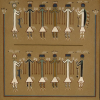billfold
Similar to a capacious envelope, a billfold, sometimes referred to as a wallet, is usually made of leather or other pliable yet durable material and is designed to carry paper money and credit cards. Billfolds are usually small enough to be shoved in a back pocket of a pair of jeans.










